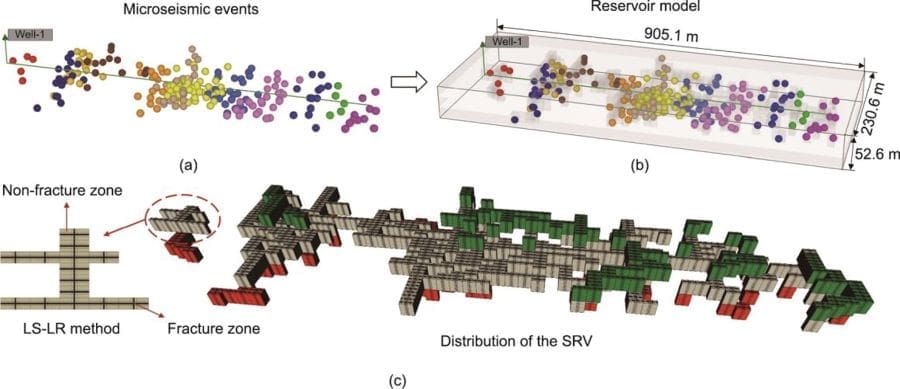Summary:
A recent study published in Engineering presents a detailed simulation-based assessment of cyclic CO2 injection as a dual-purpose strategy to enhance oil recovery and improve long-term carbon storage in unconventional reservoirs. Focusing on the Triassic Baikouquan formation in China’s Mahu Sag, researchers led by Bing Wei and Valeriy Kadet developed a highly calibrated reservoir model to investigate the dynamics of CO2 distribution, migration, and transformation underground over a ten-year injection period.
By incorporating microseismic data, geomechanical stresses, and geochemical interactions, the model closely replicated the complex behaviors of CO2 –oil–brine–rock systems after hydraulic fracturing. The simulations revealed that 48.3% of the injected CO2 was securely stored underground, with a 3.4% increase in oil recovery. However, the formation of multiple CO2 storage forms — such as dissolved CO2 in water, mineralized carbonates, and trapped gas — reduced the mixing zone between CO2 and oil by 25.9%, slightly lowering cumulative oil production.
The study highlights that most of the stored CO2 resided in the non-fractured reservoir zones, with 20% of injected CO2 reaching long-term storage forms. While offering practical insights into CO2 migration and trapping mechanisms, the work also underlines key limitations, such as simplifications in geomechanical modeling, pointing to future areas of refinement.

Cyclic CO2 injection: a promising approach for unconventional reservoirs
As the world seeks ways to mitigate climate change, carbon capture, utilization, and storage (CCUS) technologies are becoming increasingly important. Among them, CO2-enhanced oil recovery (CO2-EOR) shows great potential. However, in unconventional reservoirs like tight and shale oil, the mechanisms of CO2-EOR and storage are distinct from traditional ones.
The research teams, led by Bing Wei and Valeriy Kadet, established a reservoir model using CMG-GEM software. They integrated various factors such as CO2 solubility, molecular diffusion, geochemical reactions, and rock stress sensitivity into the model. The model was calibrated with experimental data to ensure its accuracy.
The study focused on the Triassic Baikouquan formation in the Mahu Sag, a typical tight reservoir. Through numerical simulations, the researchers investigated the performance of CO2 utilization and geological storage during cyclic injection. They compared two cases: one only considering CO2–crude oil interactions, and the other incorporating all CO2 storage mechanisms.
The results show that after ten cycles of CO2 injection, the oil recovery of the reservoir increased by 3.4% of the original oil in place (OOIP), and 48.3% of the injected CO2 was stored underground. However, the CO2 storage process reduced the CO2–oil interactions, leading to a 25.9% reduction of the CO2–oil mixing zone and a 2.2% decline in cumulative oil production.
The researchers also analyzed the migration and transformation of CO2 in the reservoir. They found that different forms of CO2 storage, such as dissolved in oil, water, and mineralized carbonate, were affected by the cyclic injection process. For example, the dissolved CO2 in oil accounted for over half of the total storage but had the potential to be released during production.
The study investigated the geochemical reactions and porosity/permeability changes in the reservoir. The dissolution and precipitation of minerals were found to have a significant impact on the reservoir properties. After ten cycles, the porosity decreased by 0.86% and 0.81% in the non-fractured and fractured zones, respectively, while the permeability decreased by 2.51% and 2.39%.
Although the research provides valuable insights into the dynamic CO2 transport and transformation processes, it also has limitations. The simplification of the geomechanical module and the uncertainty of the reactive surface area (RSA) parameter need to be addressed in future studies.
This research offers a more comprehensive and precise framework for assessing CO2 capture, utilization, and storage with enhanced oil recovery (CCUS-EOR) performance in unconventional reservoirs after fracturing. It provides support for the design and optimization of injection–production schemes, and paves the way for further research in this field.
Journal Reference:
Jinzhou Zhao, Lele Wang, Bing Wei, Valeriy Kadet, ‘CO2 Utilization and Geological Storage in Unconventional Reservoirs After Fracturing’, Engineering (2025). DOI: 10.1016/j.eng.2025.01.005
Article Source:
Press Release/Material by Higher Education Press
Featured image credit: jcomp | Freepik




